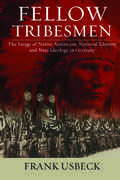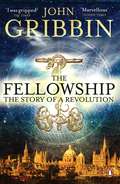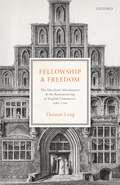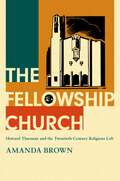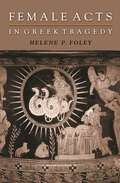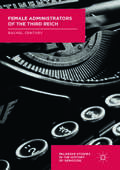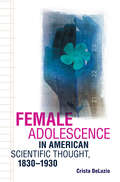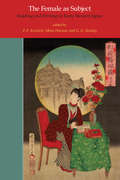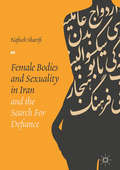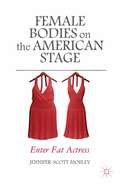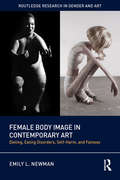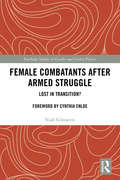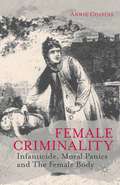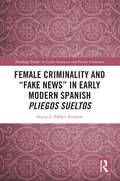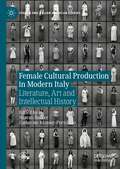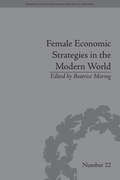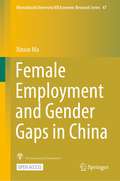- Table View
- List View
Fellow Tribesmen: The Image of Native Americans, National Identity, and Nazi Ideology in Germany (Studies in German History #19)
by Frank UsbeckThroughout the nineteenth and twentieth centuries, Germans exhibited a widespread cultural passion for tales and representations of Native Americans. This book explores the evolution of German national identity and its relationship with the ideas and cultural practices around “Indianthusiasm.” Pervasive and adaptable, imagery of Native Americans was appropriated by Nazi propaganda and merged with exceptionalist notions of German tribalism, oxymoronically promoting the Nazis’ racial ideology. This book combines cultural and intellectual history to scrutinize the motifs of Native American imagery in German literature, media, and scholarship, and analyzes how these motifs facilitated the propaganda effort to nurture national pride, racial thought, militarism, and hatred against the Allied powers among the German populace.
The Fellowship: The Story of a Revolution
by John GribbinFrom the bestselling author of Science: A History comes the enthralling story of a revolution that shook the world. Seventeenth-century England was racked by civil war, plague and fire; a world ruled by superstition and ignorance. A series of meetings of 'natural philosophers' in Oxford and London saw the beginning of a new method of thinking based on proof and experiment. John Gribbin's gripping, colourful account of this unparalleled time of discovery explores the impact of the Royal Society, culminating with Isaac Newton's revolutionary description of the universe and Edmund Halley's prediction of the return of a comet in 1759. This compelling book shows the triumph not as the work of one isolated genius, but of a Fellowship.
Fellowship and Freedom: The Merchant Adventurers and the Restructuring of English Commerce, 1582-1700
by Thomas LengThis is the first modern study of the Fellowship of Merchant Adventurers - England's most important trading company of the sixteenth century - in its final century of existence as a privileged organisation. Over this period, the Company's main trade, the export of cloth to northwest Europe, was overshadowed by rising traffic with the wider world, whilst its privileges were continually criticised in an era of political revolution. But the Company and its membership were not passive victims of these changes; rather, they were active participants in the commercial and political dramas of the century. Using thousands of neglected private merchant papers, Fellowship and Freedom views the Company from the perspective of its members, in the process bringing to life the complex social worlds of early modern merchants. For members, 'freedom' meant not just the right to access a privileged market, but also to trade independently, which could conflict with the 'fellowship' of corporate affiliation, and the responsibilities to the collective that it entailed. The study's major theme is the challenge of maintaining corporate unity in the face of this and other pressures that the Company faced. It restores the centrality of the Merchant Adventurers within three important historical narratives: England's transition from the margins to the centre of the European, and later global, economy; the rise and fall of the merchant corporation as a major form of commercial government in premodern Europe; and the political history of the corporation in an era of state formation and revolution.
Fellowship and Freedom: The Merchant Adventurers and the Restructuring of English Commerce, 1582-1700
by Thomas LengThis is the first modern study of the Fellowship of Merchant Adventurers - England's most important trading company of the sixteenth century - in its final century of existence as a privileged organisation. Over this period, the Company's main trade, the export of cloth to northwest Europe, was overshadowed by rising traffic with the wider world, whilst its privileges were continually criticised in an era of political revolution. But the Company and its membership were not passive victims of these changes; rather, they were active participants in the commercial and political dramas of the century. Using thousands of neglected private merchant papers, Fellowship and Freedom views the Company from the perspective of its members, in the process bringing to life the complex social worlds of early modern merchants. For members, 'freedom' meant not just the right to access a privileged market, but also to trade independently, which could conflict with the 'fellowship' of corporate affiliation, and the responsibilities to the collective that it entailed. The study's major theme is the challenge of maintaining corporate unity in the face of this and other pressures that the Company faced. It restores the centrality of the Merchant Adventurers within three important historical narratives: England's transition from the margins to the centre of the European, and later global, economy; the rise and fall of the merchant corporation as a major form of commercial government in premodern Europe; and the political history of the corporation in an era of state formation and revolution.
The Fellowship Church: Howard Thurman and the Twentieth-Century Religious Left
by Amanda BrownThe Fellowship Church explores the evolution of the American religious left through a case study of the African American intellectual and theologian Howard Thurman, and the physical embodiment of his thought: The Church for the Fellowship of All Peoples. The Fellowship Church, which Thurman co-founded in San Francisco in 1944, was the nation's first interracial, intercultural, and interfaith church. Amidst the growing nationalism of the World War II era and the heightened suspicion of racial and cultural "others," the Fellowship Church successfully established a pluralistic community based on the idea that "if people can come together in worship, over time would emerge a unity that would be stronger than socially imposed barriers." Rooted in the belief that social change was inextricably connected to internal, psychological transformation and the personal realization of the human community, it was an early expression of Christian nonviolent activism within the long Civil Rights Movement. The Fellowship Church was a product of evolving twentieth-century ideas and a reflection of the shifting mid-century American public consciousness. This book examines a broad scope of modern themes including the philosophy of pragmatism; mysticism and Christian liberalism; racism and imperialism; cosmopolitanism and pluralism; war and pacifism; and nonviolence. Not only does it expand on our understanding of twentieth-century American intellectual history and the origins of the Civil Rights Movement, it offers an exciting look into ways people have initiated grassroots activism during times when government has failed to protect its citizens' civil liberties, safety, and overall wellbeing through judicial safeguards.
The Fellowship Church: Howard Thurman and the Twentieth-Century Religious Left
by Amanda BrownThe Fellowship Church explores the evolution of the American religious left through a case study of the African American intellectual and theologian Howard Thurman, and the physical embodiment of his thought: The Church for the Fellowship of All Peoples. The Fellowship Church, which Thurman co-founded in San Francisco in 1944, was the nation's first interracial, intercultural, and interfaith church. Amidst the growing nationalism of the World War II era and the heightened suspicion of racial and cultural "others," the Fellowship Church successfully established a pluralistic community based on the idea that "if people can come together in worship, over time would emerge a unity that would be stronger than socially imposed barriers." Rooted in the belief that social change was inextricably connected to internal, psychological transformation and the personal realization of the human community, it was an early expression of Christian nonviolent activism within the long Civil Rights Movement. The Fellowship Church was a product of evolving twentieth-century ideas and a reflection of the shifting mid-century American public consciousness. This book examines a broad scope of modern themes including the philosophy of pragmatism; mysticism and Christian liberalism; racism and imperialism; cosmopolitanism and pluralism; war and pacifism; and nonviolence. Not only does it expand on our understanding of twentieth-century American intellectual history and the origins of the Civil Rights Movement, it offers an exciting look into ways people have initiated grassroots activism during times when government has failed to protect its citizens' civil liberties, safety, and overall wellbeing through judicial safeguards.
Female Acts in Greek Tragedy
by Helene P. FoleyAlthough Classical Athenian ideology did not permit women to exercise legal, economic, and social autonomy, the tragedies of Aeschylus, Sophocles, and Euripides often represent them as influential social and moral forces in their own right. Scholars have struggled to explain this seeming contradiction. Helene Foley shows how Greek tragedy uses gender relations to explore specific issues in the development of the social, political, and intellectual life in the polis. She investigates three central and problematic areas in which tragic heroines act independently of men: death ritual and lamentation, marriage, and the making of significant ethical choices. Her anthropological approach, together with her literary analysis, allows for an unusually rich context in which to understand gender relations in ancient Greece. This book examines, for example, the tragic response to legislation regulating family life that may have begun as early as the sixth century. It also draws upon contemporary studies of virtue ethics and upon feminist reconsiderations of the Western ethical tradition. Foley maintains that by viewing public issues through the lens of the family, tragedy asks whether public and private morality can operate on the same terms. Moreover, the plays use women to represent significant moral alternatives. Tragedy thus exploits, reinforces, and questions cultural clichés about women and gender in a fashion that resonates with contemporary Athenian social and political issues.
Female Acts in Greek Tragedy
by Helene P. FoleyAlthough Classical Athenian ideology did not permit women to exercise legal, economic, and social autonomy, the tragedies of Aeschylus, Sophocles, and Euripides often represent them as influential social and moral forces in their own right. Scholars have struggled to explain this seeming contradiction. Helene Foley shows how Greek tragedy uses gender relations to explore specific issues in the development of the social, political, and intellectual life in the polis. She investigates three central and problematic areas in which tragic heroines act independently of men: death ritual and lamentation, marriage, and the making of significant ethical choices. Her anthropological approach, together with her literary analysis, allows for an unusually rich context in which to understand gender relations in ancient Greece. This book examines, for example, the tragic response to legislation regulating family life that may have begun as early as the sixth century. It also draws upon contemporary studies of virtue ethics and upon feminist reconsiderations of the Western ethical tradition. Foley maintains that by viewing public issues through the lens of the family, tragedy asks whether public and private morality can operate on the same terms. Moreover, the plays use women to represent significant moral alternatives. Tragedy thus exploits, reinforces, and questions cultural clichés about women and gender in a fashion that resonates with contemporary Athenian social and political issues.
Female Administrators of the Third Reich (Palgrave Studies in the History of Genocide)
by Rachel CenturyThis book compares female administrators who specifically chose to serve the Nazi cause in voluntary roles with those who took on such work as a progression of established careers. Under the Nazi regime, secretaries, SS-Helferinnen (female auxiliaries for the SS) and Nachrichtenhelferinnen des Heeres (female auxiliaries for the army) held similar jobs: taking dictation, answering telephones, sending telegrams. Yet their backgrounds and degree of commitment to Nazi ideology differed markedly. The author explores their motivations and what they knew about the true nature of their work. These women had access to information about the administration of the Holocaust and are a relatively untapped resource. Their recollections shed light on the lives, love lives, and work of their superiors, and the tasks that contributed to the displacement, deportation and death of millions. The question of how gender intersected with Nazism, repression, atrocity and genocide forms the conceptual thread of this book.
Female Adolescence in American Scientific Thought, 1830–1930 (New Studies in American Intellectual and Cultural History)
by Crista DeLuzioIn this groundbreaking study, Crista DeLuzio asks how scientific experts conceptualized female adolescence in the nineteenth and early twentieth centuries. Revisiting figures like G. Stanley Hall and Margaret Mead and casting her net across the disciplines of biology, psychology, and anthropology, DeLuzio examines the process by which youthful femininity in America became a contested cultural category.Challenging accepted views that professionals "invented" adolescence during this period to understand the typical experiences of white middle-class boys, DeLuzio shows how early attempts to reconcile that conceptual category with "femininity" not only shaped the social science of young women but also forced child development experts and others to reconsider the idea of adolescence itself. DeLuzio’s provocative work permits a fuller understanding of how adolescence emerged as a "crisis" in female development and offers insight into why female adolescence remains a social and cultural preoccupation even today.
Female Adolescence in American Scientific Thought, 1830–1930 (New Studies in American Intellectual and Cultural History)
by Crista DeLuzioIn this groundbreaking study, Crista DeLuzio asks how scientific experts conceptualized female adolescence in the nineteenth and early twentieth centuries. Revisiting figures like G. Stanley Hall and Margaret Mead and casting her net across the disciplines of biology, psychology, and anthropology, DeLuzio examines the process by which youthful femininity in America became a contested cultural category.Challenging accepted views that professionals "invented" adolescence during this period to understand the typical experiences of white middle-class boys, DeLuzio shows how early attempts to reconcile that conceptual category with "femininity" not only shaped the social science of young women but also forced child development experts and others to reconsider the idea of adolescence itself. DeLuzio’s provocative work permits a fuller understanding of how adolescence emerged as a "crisis" in female development and offers insight into why female adolescence remains a social and cultural preoccupation even today.
The Female as Subject: Reading and Writing in Early Modern Japan (Michigan Monograph Series in Japanese Studies #70)
by P. F. Kornicki Mara Patessio G. G. RowleyMichigan Monograph Series in Japanese Studies No. 70 The Female as Subject reveals the rich and lively world of literate women in Japan from 1600 through the early twentieth century. Eleven essays by an international group of scholars from Europe, Japan, and North America examine what women of different social classes read, what books were produced specifically for women, and the genres in which women themselves chose to write. The authors explore the different types of education women obtained and the levels of literacy they achieved, and they uncover women’s participation in the production of books, magazines, and speeches. The resulting depiction of women as readers and writers is also enhanced by thirty black-and-white illustrations. For too long, women have been largely absent from accounts of cultural production in early modern Japan. By foregrounding women, the essays in this book enable us to rethink what we know about Japanese society during these centuries. The result is a new history of women as readers, writers, and culturally active agents. The Female as Subject is essential reading for all students and teachers of Japan during the Edo and Meiji periods. It also provides valuable comparative data for scholars of the history of literacy and the book in East Asia.
Female Bodies and Sexuality in Iran and the Search for Defiance (PDF)
by Nafiseh SharifiThis book uses storytelling as an analytical tool for following wider social attitude changes towards sex and female sexuality in Iran. Women born in 1950s Iran grew up during the peak of secularization and modernization, whereas those born in the 1980s were raised under the much stricter rules of the Islamic Republic. Using extensive ethnographic research, the author juxtaposes narratives of body and sexuality shared by these different generations of women, showing the intricate ways in which women construct and convey meanings and communicate their emotions about the unspoken aspects of their lives.
Female Bodies on the American Stage: Enter Fat Actress
by J. MobleyThe fat female body is a unique construction in American culture that has been understood in various ways during the twentieth and early twenty-first centuries. Analyzing post-WWII stage and screen performances, Mobley argues that the fat actress's body signals myriad cultural assumptions and suggests new ways of reading the body in performance.
Female Body Image in Contemporary Art: Dieting, Eating Disorders, Self-Harm, and Fatness (Routledge Research in Gender and Art)
by Emily L. NewmanNumerous contemporary artists, particularly female artists, have chosen to examine the idealization of the female body. In this crucial book, Emily L. Newman focuses on a number of key themes including obesity, anorexia, bulimia, dieting, self-harm, and female body image. Many artists utilize their own bodies in their work, and in the act of trying to critique the diet industry, they also often become complicit, as they strive to lose weight themselves. Making art and engaging eating disorder communities (in real life and online) often work to perpetuate the illnesses of themselves or others. A core group of artists has worked to show bodies that are outside the norm, paralleling the rise of fat activism in the 1990s and 2000s. Interwoven throughout this inclusive study are related interdisciplinary concerns including sociology, popular culture, and feminism.
Female Body Image in Contemporary Art: Dieting, Eating Disorders, Self-Harm, and Fatness (Routledge Research in Gender and Art)
by Emily L. NewmanNumerous contemporary artists, particularly female artists, have chosen to examine the idealization of the female body. In this crucial book, Emily L. Newman focuses on a number of key themes including obesity, anorexia, bulimia, dieting, self-harm, and female body image. Many artists utilize their own bodies in their work, and in the act of trying to critique the diet industry, they also often become complicit, as they strive to lose weight themselves. Making art and engaging eating disorder communities (in real life and online) often work to perpetuate the illnesses of themselves or others. A core group of artists has worked to show bodies that are outside the norm, paralleling the rise of fat activism in the 1990s and 2000s. Interwoven throughout this inclusive study are related interdisciplinary concerns including sociology, popular culture, and feminism.
Female Combatants after Armed Struggle: Lost in Transition? (Routledge Studies in Gender and Global Politics)
by Niall GilmartinThis book stems from a simple ‘feminist curiosity’ that can be succinctly summed up into a single question: what happens to combatant women after the war? Based on in-depth interviews with 40 research participants, mostly former combatants within the Irish Republican Army (IRA), this book offers a critical exploration of republican women and conflict transition in the North of Ireland. Drawing on the feminist theory of a continuum of violence, this book finds that the dichotomous separation of war and peace within conventional approaches represents a gendered fiction. Despite undertaking wartime roles that were empowering, agentic, and subversive, this book finds that the ‘post-conflict moment’ as experienced by female combatants represents not peace and security, but a continuity of gender discrimination, violence, injustice, and insecurity. The experiences and perspectives contained in this book challenge the discursive deployment of terms such as post-conflict, peace, and security, and moreover, shed light on the many forms of post-war activism undertaken by combatant women in pursuit of peace, equality, and security. The book represents an important intervention in the field of gender, political violence, and peace, and more specifically, female combatants and conflict transition. It is analytically significant in its exploration of the ways in which gender operates within non-state military movements emerging from conflict, and will be of interest to students and scholars alike.
Female Combatants after Armed Struggle: Lost in Transition? (Routledge Studies in Gender and Global Politics)
by Niall GilmartinThis book stems from a simple ‘feminist curiosity’ that can be succinctly summed up into a single question: what happens to combatant women after the war? Based on in-depth interviews with 40 research participants, mostly former combatants within the Irish Republican Army (IRA), this book offers a critical exploration of republican women and conflict transition in the North of Ireland. Drawing on the feminist theory of a continuum of violence, this book finds that the dichotomous separation of war and peace within conventional approaches represents a gendered fiction. Despite undertaking wartime roles that were empowering, agentic, and subversive, this book finds that the ‘post-conflict moment’ as experienced by female combatants represents not peace and security, but a continuity of gender discrimination, violence, injustice, and insecurity. The experiences and perspectives contained in this book challenge the discursive deployment of terms such as post-conflict, peace, and security, and moreover, shed light on the many forms of post-war activism undertaken by combatant women in pursuit of peace, equality, and security. The book represents an important intervention in the field of gender, political violence, and peace, and more specifically, female combatants and conflict transition. It is analytically significant in its exploration of the ways in which gender operates within non-state military movements emerging from conflict, and will be of interest to students and scholars alike.
Female Criminality: Infanticide, Moral Panics and The Female Body
by A. CossinsThis is the first book to consider the moral regulation of the female body through an analysis of the crime of infanticide. An in-depth perspective from the nineteenth century to the present, Cossins provides a revealing insight into the history of a little-known but widespread social crime.
Female Criminality and “Fake News” in Early Modern Spanish Pliegos Sueltos (Routledge Studies in Latin American and Iberian Literature)
by Stacey L. Parker AronsonThis book studies the Early Modern Spanish broadsheet, the tabloid newspaper of its day which functioned to educate, entertain, and indoctrinate its readers, much like today’s "fake news." Parker Aronson incorporates a socio-historical approach in which she considers crime and deviance committed by women in Early Modern Spain and the correlation between crime and the growth of urban centers. She also considers female deviance more broadly to encompass sexual and religious deviance while investigating the relationship between these pliegos sueltos and the transgressive and disruptive nature of female criminality. In addition to an introduction to this fascinating subgenre of Early Modern Spanish literature, Parker Aronson analyzes the representations of women as bandits and highway robbers; as murderers; as prostitutes, libertines, and actors; as Christian renegades; as enlaved people; as witches; as miscegenationists; and as the recipients of punishment.
Female Criminality and “Fake News” in Early Modern Spanish Pliegos Sueltos (Routledge Studies in Latin American and Iberian Literature)
by Stacey L. Parker AronsonThis book studies the Early Modern Spanish broadsheet, the tabloid newspaper of its day which functioned to educate, entertain, and indoctrinate its readers, much like today’s "fake news." Parker Aronson incorporates a socio-historical approach in which she considers crime and deviance committed by women in Early Modern Spain and the correlation between crime and the growth of urban centers. She also considers female deviance more broadly to encompass sexual and religious deviance while investigating the relationship between these pliegos sueltos and the transgressive and disruptive nature of female criminality. In addition to an introduction to this fascinating subgenre of Early Modern Spanish literature, Parker Aronson analyzes the representations of women as bandits and highway robbers; as murderers; as prostitutes, libertines, and actors; as Christian renegades; as enlaved people; as witches; as miscegenationists; and as the recipients of punishment.
Female Cultural Production in Modern Italy: Literature, Art and Intellectual History (Italian and Italian American Studies)
by Sharon Hecker Catherine Ramsey-PortolanoThis book is the first critical interdisciplinary examination in English of Italian women’s contributions to intellectual, artistic, and cultural production in modern Italy. Examining commonalities and diversities from the country’s Unification to today, the volume provides insight into the challenges that Italian women engaged in cultural production have faced, and the strategies they have deployed in order to achieve their objectives. The essays address a range of issues, from women’s self-identification and public ownership of their professional roles as laborers in the intellectual and cultural realm, to questions about motherhood and financial remuneration, to the role of creative foreign women in Italy. Through critical analysis and direct testimony from new and typically marginalized voices, including an Arab-Italian writer, an Italian-Dominican filmmaker, and a transgender activist, new forms of ongoing struggle emerge that redefine the culturally diverse landscape of female intellectual and creative production in Italy today. The volume rethinks a solely national “Made in Italy” reading of the subject of female intellectual labor, demonstrating instead the wide network of influences and relationships that have existed for Italian women in their professional aspirations.
Female Economic Strategies in the Modern World (Perspectives in Economic and Social History)
by Beatrice MoringThis collection of essays looks at the various ways in which women have coped financially in a male-dominated world. Chapters focus on Europe and Latin America, and cover the whole of the modern period.
Female Economic Strategies in the Modern World (Perspectives in Economic and Social History #22)
by Beatrice MoringThis collection of essays looks at the various ways in which women have coped financially in a male-dominated world. Chapters focus on Europe and Latin America, and cover the whole of the modern period.
Female Employment and Gender Gaps in China (Hitotsubashi University IER Economic Research Series #48)
by Xinxin MaThis open access book investigates female employment and the gender gap in the labor market and households during China’s economic transition period. It provides the reader with academic evidence for understanding the mechanism of female labor force participation, the determinants of the gender gap in the labor market, and the impact of policy transformation on women’s wages and employment in China from an economics perspective. The main content of this book includes three parts―women’s family responsibilities and women’s labor supply (child care, parent care, and women’s employment), the gender gap in the labor market and society (gender gaps in wages, Communist Party membership, and participation in social activity), and the impacts of policy transformation on women’s wages and employment (the social security system and the educational expansion policy on women’s wages and employment) in China. This book provides academic evidence about these issues based on economics theories and econometric analysis methods using many kinds of long-term Chinese national survey data. This book is highly recommended to readers who are interested in up-to-date and in-depth empirical studies of the gender gap and women’s employment in China during the economic transition period. This book is of interest to various groups such as readers who are interested in the Chinese economy, policymakers, and scholars with econometric analysis backgrounds.
